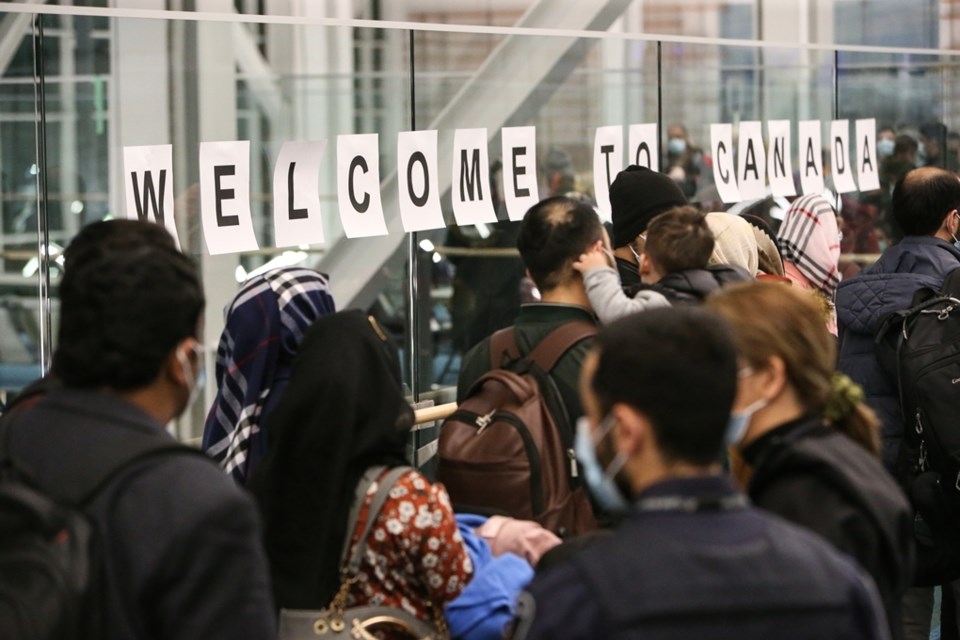ÎÚÑ»´«Ã½ is building fewer and fewer homes for its growing population as immigrants — who will soon account for all the country’s growth — continue to show a heightened desire for home ownership, municipal politicians and city planners were told at a housing conference April 5 in Vancouver.
And, the unchecked disparity between building new dwellings and bringing in more immigrants is a leading cause of the country’s housing affordability crisis, according to experts at the Union of Municipalities of BC housing conference.
Geographer and migration expert Dan Hiebert, a researcher for Immigration Refugees and Citizenship ÎÚÑ»´«Ã½, says ÎÚÑ»´«Ã½’s effort to build new housing for new residents has slowly declined over the past 20 years. In 2004, the country was building about 700 new dwellings per 1,000 new residents, whereas now, it is only building 460 dwellings.
“The trendline is consistently downward since then. We saw a historic shortage and then a ramping up of that shortage,” said Hiebert, noting ÎÚÑ»´«Ã½ falls below the average for countries of the Organization for Economic Co-operation and Development (OECD).
The result is the highest increase in house prices among the OECD, said Hiebert.
Immigrant settlement services are stretched thin finding housing
Chris Friesen, chief operating officer of the Immigrant Services Society of BC, told the conference that politically crafted housing plans are failing to match immigration targets set by the federal government, case in point the Homes for ÎÚÑ»´«Ã½ policy book on housing affordability.
“Nowhere in the plan is there a mention of immigration and refugees. There’s a disconnect here and we need to close the loopholes,” said Friesen, calling on provincial policymakers to align housing plans with a population growth strategy.
“If we can do the economic projections then it’s time to do the population growth projections for the next 10 years,” said Friesen, noting by about 2032 all net population growth will come from immigration (more Canadians are on pace to die than be born, as the domestic birthrate, now at 1.4 births per woman, gradually plummets).
At a more granular level, Friesen said part of the policy problem is that population projections are not counting the vast new numbers of temporary residents in the country.
Last year, about 60,000 new permanent residents moved into ÎÚÑ»´«Ã½ but about 140,000 temporary residents (foreign workers and international students) also came here. These temporary residents are driven by demand from industry and educational institutions.
But, said Friesen, “Forget about the legal categories, because at the end of the day it’s people who need a house.”
Friesen said ÎÚÑ»´«Ã½ faces a potentially fraught scenario with about 850,000 approved but not landed Ukrainian visa applicants set to expire by March 31, 2024. Those applicants will need to decide by then if they are coming to ÎÚÑ»´«Ã½, said Friesen.
“There is no housing policy considered. Yes, there is a humanitarian need as a result of this crisis but now we’re catching up on the ground,” said Friesen.
Friesen said his society has 13 staff members and 60 per cent of those they are assisting are ending up in basement suites in Surrey.
Hiebert said the housing pressure from immigrants landing in big Canadian cities like Montreal, Toronto and Vancouver is easing; in 2001, 73 per cent of immigrants landed there, whereas now the ratio is just 53 per cent.
“So there’s been a pretty big shift to smaller places, such as Kelowna,” said Hiebert, who told of statistics showing immigrants prefer home ownership.
Hiebert cited polling that indicates 75 per cent of immigrants think owning a home makes one feel Canadian whereas just 59 per cent of those born here think likewise.
Hiebert said immigrants are more likely to pool their resources and income together to buy a home. And this partly explains why 78 per cent of recent home purchases were made by immigrants, he said.
“Immigrants are more enthusiastic and more dedicated to home ownership than the general population,” he said, while not ignoring the sheer volume of them puts “immediate pressure” on the rental market.
The discussion did not veer into whether the best lever to pull is decreasing immigration targets or simply ramping up housing to meet whatever those targets may be; or, a combination of both.
Cities must react to federal policies but also need labourers, now in short supply
West Vancouver councillor Linda Watt expressed frustration in how cities are left to react to federal immigration targets, which will reach about 451,000 next year, up from about 330,000 in 2019.
“We all agree we need immigration, but it is so aggressive, and we’re being painted into a corner,” said Watt.
Hiebert indicated that there’s nearly no end in sight in terms of demand to come here, noting one in eight of over 200,000 people polled by Galup Inc. across the world wished to move to another country and ÎÚÑ»´«Ã½ was their second choice behind the United States.
In terms of building the homes required for population growth, David van Hemmen, vice-president of the Greater Vancouver Board of Trade, said this too will depend on immigration, as ÎÚÑ»´«Ã½ must attract, train and retain construction workers.
Van Hemmen said ÎÚÑ»´«Ã½ has 170,000 workers in construction but 25 per cent are set to retire in the next five years and, “We don’t have a plan for that.”
With some irony, he said it is high housing costs preventing skilled labourers from coming to ÎÚÑ»´«Ã½ Whereas a few years ago the discussion was about retaining the baristas of the workforce, now it is construction jobs once considered well-paying that can no longer suffice.
“A lot of people are thinking of leaving,” said Friesen.
At the conference, Premier David Eby said the province’s housing costs are jeopardizing the whole of the economy.



